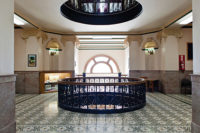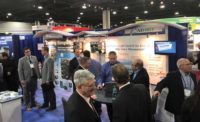Searching for Green Technology
Sherry Seright is the budget director for Muscatine County. She said that a dozen years ago there were growing signs that the more than 30-year-old cooling and heating system would soon need to be replaced. “We found water in the basement from the old boilers, and the pipes were starting to leak. The indoor units were loud, moldy, and fuzzy, and everyone disliked the huge, ugly condenser unit sitting prominently on the roof of our handsome Beaux Arts building, spoiling the view,” she said.
Seright gives a lot of credit to the Muscatine County Board of Supervisors. “Conscious of safeguarding taxpayer dollars, county governments are not known for being on the cutting edge of technology, but the board wanted to learn more about going green as far back as 2001,” she said. “Looking for ways to better manage county energy usage, the board even invested in drilling a geothermal test well in anticipation of replacing the old system.”
Courthouse Recognized by Energy Star
In 2002, the board authorized the construction of a 25,000-square-foot county conservation learning center using a geothermal cooling and heating system. Several years later, the members approved funding for replacing the century-old original windows throughout the courthouse. This effort brought grants from the U.S. Department of Energy and the Iowa Office of Energy Independence. The courthouse also became one of only a handful of courthouses in the United States to earn an Energy Star certification.
The board knew it was time to replace the failing, outdated HVAC system and sent out a request for proposal (RFP) to local design firms asking for proposals. One responder was Vic Amoroso, a 40-year HVAC design engineer and president of A&J Associates PC, North Liberty, Iowa. Amoroso showed the board the basics of a closed-loop geothermal system and how smoothly it would work in tandem with a variable refrigerant flow (VRF) zoning system from Mitsubishi Electric Cooling & Heating. “He proved to us that this would be less expensive than replacing our current system with new boilers and chillers.”
VRF and Geothermal
“We are a small engineering firm,” Amoroso said, “and questioning traditional design is the reason we have been successful over the years. We prefer unusual projects not being widely designed, like geothermal and radiant cooling/heating. That’s why I was intrigued when Paul Ebeling, a sales engineer from The Trane Company [Davenport, Iowa] walked into my office in 2007 with Bruce Senti, an independent sales representative from Mitsubishi Electric. He wanted to introduce A&J to a VRF zoning technology that was still relatively new in the U.S., although it has been popular in Europe and Asia for decades.”
Senti explained to Amoroso how this VRF zoning water-source system would interface with a geothermal field. “Our new W-Series modular units perfectly combine the energy effectiveness of geothermal systems with the excellent efficiencies of our VRF zoning technology,” Senti told him. “These new units are 30 percent smaller than previous models and can be easily transported down the stairs into the basement of the courthouse. By connecting to the geothermal loop, backup heat would not be needed.” He noted that this system’s dry mode is perfect for the months of July and August, which can make Iowa feel like a greenhouse.
Because of the hot, humid Iowa summers, Senti recommended another key VRF zoning product, a Mitsubishi Electric City Multi® dedicated outdoor air system (DOAS). The DOAS would supply outdoor ventilation air to the courthouse, delivering the proper amount of fresh air to each room, and provide ample dehumidification during the humid Iowa summers without excessive reheat. The DOAS would also increase the VRF zoning system’s energy efficiency, because it pre-conditions outside air for introduction into the downstream HVAC units, lessening the load on the HVAC system.
The fact that the DOAS and the VRF zoning system were designed to work together was appealing to Senti. “The DOAS from Mitsubishi Electric was very convenient for us,” he said.
“Because the outdoor air system and the VRF system were manufactured by the same company, we didn’t have to cobble together a system with components from different manufacturers that might decrease the system’s energy efficiency. Additionally, this system combination provided us with a one-stop shop regarding parts, warranties, installation, service, and repair.”
Amoroso was interested in the VRF zoning system because its engineering design would overcome the installation challenges posed by the 105-year-old building, with its 24-inch-thick limestone walls. He also saw that the VRF zoning system efficiencies coupled with the heat sync exchange of the campus geothermal field could serve both the courthouse and the new jail addition across the street. The geothermal campus was a hybrid, closed-loop system with 60 vertical and 40 horizontal wells.
Holding Court
“I give Vic Amoroso a lot of credit for making the transition to the new system smooth,” Seright said. “What could have been very disruptive happened harmoniously with not one office losing a day of work. This entire building is now devoted to the courts and courtroom administration. Judges were holding court [while we were making this transition], and we could not afford to have a lot of banging, pounding, and installation of new equipment.”
Mechanical contractor Heath Allard, president of Climate River Valley, Eldridge, Iowa, agreed: “This smooth installation had a lot to do with the native intelligence of the Mitsubishi Electric VRF zoning system design. … Because the W2-Series units are installed indoors, we did not have to drill through the thick limestone walls, which would have made quite a racket.”
Multiple Benefits
“There are so many benefits to this new system, it is hard to know where to begin,” Amoroso said. “First of all, there is the historic preservation accommodation of this technology, which is the least intrusive, less destructive factor of this two-pipe system. There is the super quiet aspect of all the indoor units, ideal for an office environment. It’s so quiet, people often ask if it is operating. There is the system’s remarkable dry mode setting, which has great impact on indoor comfort during our humid summers. Then, there is the unique 100 percent inverter-driven compressor that varies its speed to match the indoor cooling or heating demand. This is great engineering.”
Amoroso went on to say that the Mitsubishi Electric VRF zoning technology and the geothermal system worked well together to manage energy use. Inside the buildings, the VRF zoning system heat pumps recover excess heat generation and reuse it to heat cold spots and to warm water. When the building temperatures are satisfied, the excess heat is then shared with the second building served by the campus geothermal loop. The second building heat pump system uses the shared energy to maintain the temperatures in the jail addition. If both building temperatures are satisfied, then the excess heat is transferred to the loop field to be stored for later use.
“We sized the geothermal loop field to handle 450 gallons per minute flow at the design heating and cooling load,” Amoroso continued. “The geothermal pumps are variable speed and adjust to what is needed in the overall campus balance. We have observed this past summer that the field can handle the campus system heat transfer requirement with just 20 percent of the design flow. The savings in pumping energy alone has been tremendous. This result is due in large part to the ability of the courthouse VRF zoning system to share and save heating and cooling energy for use in the other building and for storing for later use.”
Beauty Restored
“We are all thrilled with the performance of this technology partnership,” Seright said. “As budget director, I can tell you the clearest proof of the success of our decision came when the 30,000-square-foot new jail addition came online and was tied into the campus geothermal field between both buildings. The energy bill did not move up one tick. That’s amazing proof of how this technology works.”
Because of the installation’s success, the board decided that when systems need to be replaced in other county facilities, including the old jail, the partnership of geothermal and VRF zoning systems would be the new standard. The board recently hired A&J Associates to design geothermal systems for two additional county-owned buildings.
“Perhaps best of all, we were able to remove that hideous chiller on the courthouse’s roof that spoiled its classic lines,” said Seright. “The diminutive demands of this VRF zoning system have helped us bring back the grandeur of our courthouse.”
Sidebar: Project Snapshot
Project Name: Muscatine County Courthouse
Project Location: Muscatine, Iowa
Completion Date: July 2011
The Team:
Owner: County of Muscatine, Muscatine, Iowa
Architect: Douglas J. Steinmetz Architect, Cedar Rapids
Mechanical Engineer: A&J Associates PC, North Liberty
HVAC Contractor: Climate River Valley, Eldridge
HVAC Distributor: The Trane Company, Davenport
Sidebar: A Closer Look at Equipment
For the Muscatine County Courthouse, the following Mitsubishi Electric equipment was installed:
• One PURY R2-Series outdoor unit;
• Six PQRY WR2-Series outdoor units;
• Six PLFY ceiling-concealed indoor units;
• Eight PKFY wall-mounted indoor units;
• 57 PFFY floor-standing concealed indoor units;
• One PEFY dedicated outside air system (DOAS);
• 58 PAC Simple MA remote controllers;
• 11 PAR MA remote controllers;
• Seven CMB branch circuit (BC) controllers; and
• Two AG-150A centralized controllers.
Publication date: 11/19/2012








